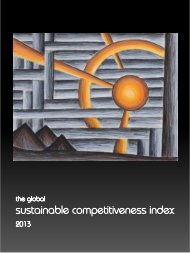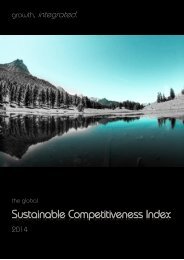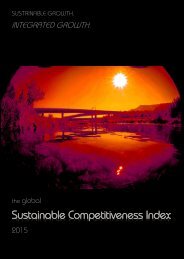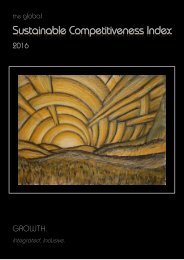The Global Sustainable Competitiveness Index 2019
Measuring competitiveness comprehensively: Sweden & Scandinavia tops, Germany #15, UK 17, US 34, China 37 in the Global Sustainable COmpetitiveness Index 2019
Measuring competitiveness comprehensively:
Sweden & Scandinavia tops, Germany #15, UK 17, US 34, China 37 in the Global Sustainable COmpetitiveness Index 2019
Create successful ePaper yourself
Turn your PDF publications into a flip-book with our unique Google optimized e-Paper software.
Methodology
Table of
Contents
8 Sustainable Competitiveness Model & Index
Methodology
8.1 The Sustainable Competitiveness Model
The three-dimensional sustainability model of reconciling the economy, the
environment and the society is often used and applied in the corporate world to
evaluate and manage sustainability issues and performance.
However, corporations are entities that operate in very
different boundaries and with different goals than
states and nation-economies. The elements of the
model therefore have to be adapted to the
characteristics of nations and their fundament of
sustained prosperity.
While corporate or economic entities (depending on
the nature of their business) are working with natural
capital, they do not depend on the location of the
capital (natural, human, financial) they utilize, and
therefore can move their operations to where the
external conditions are most favourable, both in terms
of physical location (offices/factories) and markets, as
well as in terms of business fields. Transport and
international trade have made countries and people
less dependent on their immediate environment
through international trade of resources, including
water. However, countries and population cannot simply move should
fundamental resources (water, agricultural output) become scarce or the
country inhabitable due to climate change. At the end of the day people rely
on, and life off, the natural capital of their environment for better or worse.
Model of sustainable
development often
applied in ESG research
The Sustainable Competitiveness Pyramid
Sustainable competitiveness - they ability to
generate and sustain inclusive wealth and
dignifying standard of life for all citizens in a
globalised world of competing economies,
consists of 5 key elements that interact and
influence each other: natural capital (the
given natural environment and climate, minus
human induced degradation and pollution),
social capital, intellectual capital (the ability
to compete in a globalised market through
sustained innovation), resource management
(the ability to extract the highest possible
value from existing resources (natural, human,
financial), and governance (the framework given, normally by government
policies & investments, in which a national economy operates).
The Sustainable
Competitiveness
Pyramid
33








